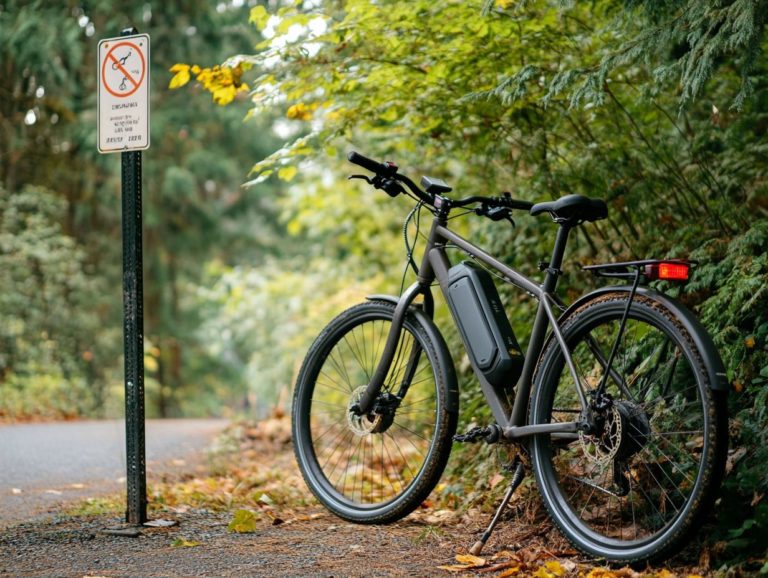The Legal Age to Ride Electric Bicycles in the US
Electric bicycles are revolutionizing the way you commute, seamlessly merging enjoyment with practicality. The popularity of electric bicycles is rising. It’s crucial to understand the age restrictions that come with them.
This overview provides insights into what electric bicycles are and explores the various types available. It also outlines the laws that govern their use across different states. From federal regulations to important safety rules and parental responsibilities, this guide equips you with the knowledge you need to ride responsibly and confidently.
Contents
- Key Takeaways:
- 1. What Are Electric Bicycles?
- 2. Different Types of Electric Bicycles
- 3. Laws and Regulations for Electric Bicycles
- 4. Federal Regulations for Electric Bicycles
- 5. State Regulations for Electric Bicycles
- 6. Age Restrictions for Riding Electric Bicycles
- 7. Differences in Age Restrictions between States
- 8. Safety Measures for Riding Electric Bicycles
- 9. Consequences of Riding Electric Bicycles Underage
- 10. How to Determine If Your Electric Bicycle Is Street Legal
- 11. Tips for Parents of Teenagers Who Want to Ride Electric Bicycles
- 12. How to Stay Informed about Changes in Regulations
- 13. Future Predictions for Electric Bicycle Regulations
- How Different Countries Set the Age for Riding Electric Bikes
- Frequently Asked Questions
- What is the legal age to ride electric bikes in the US?
- Do I need a license to ride an electric bike in the US?
- Can children ride electric bikes in the US?
- Are there any restrictions on the use of electric bikes by age in the US?
- What are the consequences of riding an electric bike under the legal age in the US?
- Can the legal age to ride electric bikes in the US change?
Key Takeaways:
1. What Are Electric Bicycles?
Electric bicycles, or e-bikes as they’re commonly called, have transformed the world of motorized travel. They offer you an eco-friendly alternative for both commuting and leisure. These innovative vehicles incorporate electric motors that assist you, making cycling more accessible than ever.
E-bikes come in different classes. Some include low-speed models that help you pedal, so your rides feel a lot less strenuous.
With operable pedals required for compliance, they not only encourage fitness but also serve as a sustainable mode of transportation, changing how we get around cities.
Typically, e-bikes include essential components like a rechargeable battery, an electric motor, and smart control systems. These systems let you easily adjust the level of assistance while riding, allowing you to cover longer distances and tackle hilly terrains with ease.
It’s no wonder electric bikes are gaining popularity! They offer many benefits, such as reduced carbon footprints and the convenience of navigating crowded city streets.
As cities increasingly move toward greener transport solutions, electric bicycles emerge as a practical means to enhance both your personal health and the environment, encouraging a shift toward more mindful commuting.
2. Different Types of Electric Bicycles
Electric bicycles fall into three primary categories: Class 1, Class 2, and Class 3. These classifications help you choose the right bike for your needs. Each classification presents distinct levels of pedal assistance and maximum speed capabilities.
Class 1 e-bikes offer assistance solely when you’re pedaling, cutting off at 20 mph. This makes them perfect for anyone seeking a more traditional cycling experience, but with a little extra boost.
In contrast, Class 2 models allow for throttle-controlled assistance, meaning you can take a break from pedaling entirely, also with a speed limit typically capped at 20 mph.
Class 3 bikes, however, are all about higher performance, delivering pedal assistance up to 28 mph. This can be particularly beneficial for commuters, though they often come with helmet requirements and specific regulations in certain areas.
Knowing these classifications enhances your ride. They help you choose the right electric bicycle for your needs and local laws.
Ready to ride? Find the perfect e-bike for your journey today!
3. Laws and Regulations for Electric Bicycles
Understanding the laws surrounding electric bicycles is crucial for a safe and legal riding experience. These rules can vary widely by location, so it’s important to check both state and local ordinances.
Navigating this legal landscape can feel overwhelming. In some areas, e-bikes need to be registered, while in others, registration may not be required.
For instance, California categorizes e-bikes into three classes, each with its own regulations. New York City mandates helmet use for all riders, regardless of bike classification.
Compliance guidelines can vary widely. Some municipalities may impose specific speed limits or require e-bikes to stick to designated cycling paths. Check local laws to ensure you re following the rules and keeping safe!
4. Federal Regulations for Electric Bicycles
Federal regulations, like the Consumer Product Safety Act, define what an electric bicycle is and maintain safety standards across the industry. The Consumer Product Safety Commission (CPSC) establishes guidelines that manufacturers must follow during design and production.
These regulations cover factors such as speed limits and component construction, impacting the safety features in e-bikes. The CPSC categorizes e-bikes based on power output and speed capabilities, guiding states in creating their specific laws.
5. State Regulations for Electric Bicycles
State regulations on electric bicycles can vary dramatically. Local authorities often implement specific laws that dictate how and where you can ride e-bikes.
California has introduced a three-tier classification system for e-bikes, influencing operational areas and helmet requirements. In contrast, New York City enforces strict speed limits in certain zones, showing how urban settings shape cycling regulations.
Florida takes a more lenient approach, allowing e-bikes in many locations while permitting local governments to impose additional guidelines. Familiarize yourself with these local ordinances to enhance your riding experience.
6. Age Restrictions for Riding Electric Bicycles
Age restrictions for riding electric bicycles are becoming increasingly prevalent due to safety concerns and local e-bike laws. These laws establish specific age requirements for riders.
These regulations ensure that younger individuals have the maturity and skills necessary to operate these vehicles safely. Many jurisdictions set a minimum age of 14 or 16, but for more details on the variations that influence the e-bike riding landscape in different areas, check out the electric bicycle age restrictions by state.
In some regions, exemptions allow younger riders to operate e-bikes under adult supervision or after completing a certification process. This is a course designed to teach young riders the skills they need to ride safely. Some states have recently revisited their e-bike laws to enhance accessibility while maintaining a focus on safety education and responsible riding practices.
7. Differences in Age Restrictions between States
Age restrictions for riding electric bicycles vary significantly between states, creating a set of rules that you need to navigate for compliance.
In some areas, there are no specific age limits, embracing independence and personal freedom. Conversely, states with stricter regulations may impose age thresholds as high as 16 or even 18 years. This is driven by safety concerns, especially regarding younger riders in places like Alabama and Massachusetts.
This variation reveals differing views on personal responsibility and shows how local attitudes influence the acceptance of technological advancements in transportation. As electric bikes gain popularity, understanding these laws offers insights into how communities strive to balance innovation with public safety.
8. Safety Measures for Riding Electric Bicycles
Implementing safety measures like adhering to helmet laws is essential for you as an electric bicycle rider to ensure a safer experience on the road.
Protect yourself and ride safely! By prioritizing protective gear such as reflective vests and knee pads, you can reduce the risk of injury during unexpected accidents.
Understanding local regulations enables you to stay within legal boundaries while fostering a culture of responsibility and awareness among all road users. Many jurisdictions impose specific age limits or speed restrictions for e-bike riders. Being well-informed about state-specific electric bicycle legal frameworks can lead to safer riding habits.
Ultimately, following these best practices not only enhances your personal safety but also promotes a more harmonious coexistence with pedestrians and motorists.
9. Consequences of Riding Electric Bicycles Underage
Riding electric bicycles underage can lead to serious consequences, including legal penalties and heightened risks of accidents. It’s crucial to follow age restrictions.
Statistics show that riders under the age of 16 are significantly more susceptible to accidents, accounting for nearly 30% of all reported e-bike injuries. Many jurisdictions enforce strict laws for electric bicycles, and violations can result in fines or other legal repercussions for both the minor and their guardians.
Case studies indicate that underage riders often lack the experience necessary to navigate potential hazards effectively. This amplifies the dangers they encounter on the roads. Therefore, understanding these risks and complying with age limitations is vital for fostering safer riding practices and safeguarding youth.
10. How to Determine If Your Electric Bicycle Is Street Legal
Determining if your electric bicycle is street legal requires understanding specific e-bike classifications and compliance with local and state laws.
Start by learning about the various categories of electric bicycles. They can differ significantly based on your location. You ll need to distinguish between bikes that help you pedal and bikes that can go faster without pedaling.
Next, check your bike’s motor specifications, including wattage and maximum speed. Most places have limits on these features. By comparing these details with local regulations, you’ll understand the requirements, which may include licenses, registration, and necessary equipment like lights and bells.
Understanding these elements improves your riding experience and ensures you stay on the right side of the law.
11. Tips for Parents of Teenagers Who Want to Ride Electric Bicycles
Parents of teenagers interested in electric bicycles play a key role in ensuring their safety and compliance with local e-bike laws and regulations.
Engage in open discussions about safe riding practices. Talk about the importance of wearing helmets and using bike lanes whenever possible. Familiarize yourselves with the specific legal requirements in your area, such as age restrictions and speed limits. This will help both you and your teen navigate the regulations confidently.
By building a culture of responsible e-bike use, which includes proper maintenance and awareness of road conditions, you enhance their safety and enjoyment while nurturing a sense of independence.
12. How to Stay Informed about Changes in Regulations
Stay updated on e-bike laws for safe riding. Access a variety of resources to enhance your understanding. Many websites focus on cycling and e-bike legislation, providing the latest information.
Local authorities, like city councils and transportation departments, often release newsletters or public announcements about regulatory changes. Keep an eye on these updates.
Community organizations advocate for cyclists and share valuable resources, news, and updates on legislative changes. Engage proactively with these resources to navigate the ever-evolving landscape of e-bike laws confidently.
13. Future Predictions for Electric Bicycle Regulations
As the popularity of electric bicycles continues to soar, expect regulations to change. These changes aim to balance innovation and safety.
Regulations may shift in how e-bikes are classified, distinguishing between different e-bike types based on their capabilities.
Safety standards will likely evolve, ensuring manufacturers meet requirements that protect both riders and pedestrians. With new technologies like improved battery designs and smart connectivity lawmakers will need to adapt existing rules.
Advocacy groups, such as PeopleForBikes, play a vital role in this conversation. They promote cycling-friendly policies, ensuring that the interests of e-bike users are represented in the regulatory landscape.
How Different Countries Set the Age for Riding Electric Bikes
Countries worldwide have various rules about the age you can ride electric bikes. These differences reflect cultural views on youth and safety.
In the Netherlands, the age to ride electric bikes is generally lower. This shows a strong trust in young riders.
However, in the United States, age restrictions tend to be stricter due to concerns about safety and liability.
Cultural views on independence and responsibility shape these rules in fascinating ways. Some countries promote early independence, while others prioritize safety over freedom.
Frequently Asked Questions
What is the legal age to ride electric bikes in the US?
The age you can ride electric bikes in the US varies by state, generally ranging from 16 to 18 years old.
Do I need a license to ride an electric bike in the US?
In most states, you do not need a driver’s license to ride an electric bike. However, some states may require specific permission for certain types of electric bikes.
Can children ride electric bikes in the US?
The minimum age for riding an electric bike in the US is typically 16, but some states may allow children as young as 14 to ride with adult supervision.
Are there any restrictions on the use of electric bikes by age in the US?
Some states may have restrictions based on age, such as prohibiting minors from riding on certain roads or requiring them to wear helmets.
What are the consequences of riding an electric bike under the legal age in the US?
Riding an electric bike under the legal age in the US may result in fines, penalties, or even legal consequences, depending on the state’s laws.
Can the legal age to ride electric bikes in the US change?
Yes, the age you can ride electric bikes in the US can change as laws and regulations are updated. Stay updated about your state’s laws they can change!



